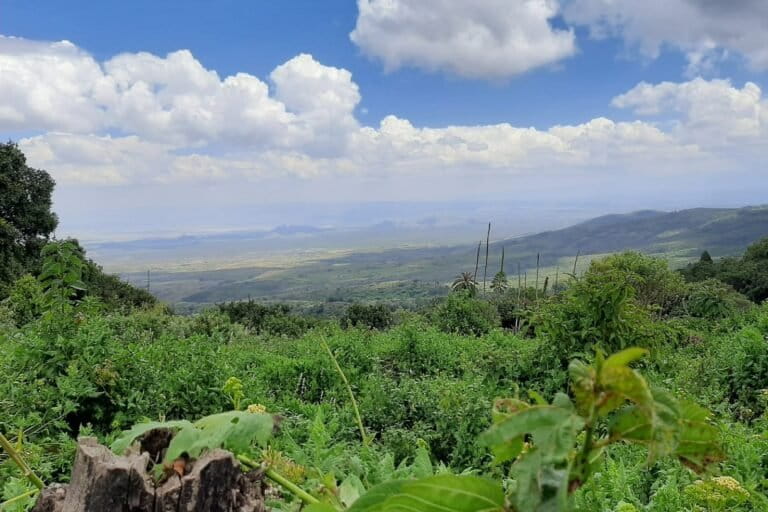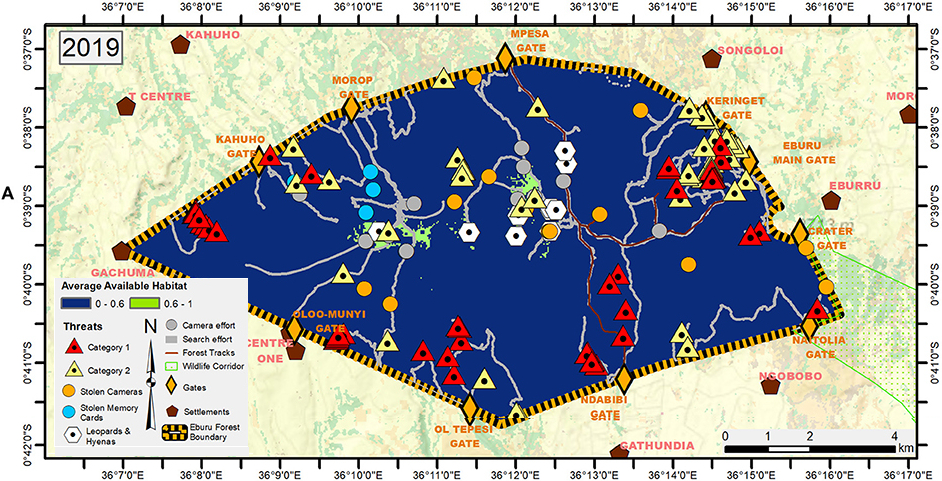- For decades, forest reserves in Kenya’s central highlands have been under pressure from surrounding communities seeking firewood, timber and space for farmland.
- This pressure has left the Eburu Forest an isolated refuge for wildlife, including the critically endangered mountain bongo.
- Sustained efforts by Rhino Ark, an environmental NGO, have built local communities’ awareness of the importance of the forest, but with few alternatives for fuel in particular, encroachment into the reserve continues.
- The NGO says it hopes the installation of household biogas systems will reduce pressure on the forest for firewood, while improving health and producing organic fertilizer for participating households.
EBURU, Kenya — The twin peaks of Mount Eburu are draped with 87 square kilometers, about 34 square miles, of montane forest. They’re home to more than 40 species of mammals, including the critically endangered mountain bongo (Tragelaphus eurycerus isaaci). Like other forest reserves in central Kenya, Eburu has suffered degradation because it’s also a source of food and fuel for surrounding communities.
This could change, though, as a household biogas project aims to reduce demand for timber, firewood, and charcoal, by providing locals an alternative source of energy.
Lydia Nyota heads one of 150 households in the village of Eburu that have begun using biogas for cooking and lighting their homes. Like most of her neighbors here, the 60-year-old used to rely on firewood and charcoal from the nearby Eburu Forest for fuel.
“We value this forest because it gives us rain and it hosts critically endangered species,” Nyota told Mongabay.

Reserves of biodiversity
Eburu is the easternmost of 22 protected forest blocks in central Kenya. Once part of the Mau Forest complex, an expanse of montane forest that’s a vital source of the water that feeds lakes and rivers across the Rift Valley region, Eburu is now an island of forest surrounded by agriculture and settlements.
Despite decades of encroachment, Eburu’s various zones — shifting from acacia and lelechwa on the lower slopes, to tall, shady Dombeya torrida trees, cone-bearing Podocoarpus, and leafy Crotalaria species at higher elevations, with highland bamboo and open grassland on the highest peaks — have remained a hotspot for bird and mammal species. The latter include harnessed bushbucks (Tragelaphus scriptus), Harvey’s red duikers (Cephalophus harveyi), leopards (Panthera pardus), and the mountain bongo, a rare striped antelope believed to number just 70-80 in the wild.
The bongo once ranged more widely across upland forests in Kenya and Uganda, but decimated by hunting and a shrinking habitat, they’re now found only at Eburu and in four other small populations scattered across other parts of the Mau Forest complex and the Aberdares. The Bongo Surveillance Project estimates around 10 of these large antelopes with their spiraling horns and white stripes on red-brown coats live in the Eburu Forest.
For decades, the forest reserve has been infiltrated by illegal loggers, hunters and others to harvest timber, charcoal, firewood. Others enter the reserve to graze livestock, search for wild honey, or to look for medicinal plants or carry out initiation rites. Some farmers have also planted crops like cassava, millet or marijuana within the protected forest’s boundaries.

Protection requires alternatives
In 2014, Rhino Ark, a charity that works in concert with the Kenya Forest Service to protect the country’s mountain forests, fenced off Eburu Forest in an attempt to keep loggers and hunters out. The organization also established tree-planting programs for both indigenous species to restore damaged forest and fruit trees to support locals’ food and income needs, expanded conservation awareness clubs in schools, and introduced portable kilns to make charcoal from crop residue.
But people continued to enter the forest, sometimes destroying sections of the fence to make regular access easier.
A team of researchers investigating the ecological and social feasibility of translocating mountain bongos into Eburu Forest from a captive-breeding program found extensive activity inside the forest. Fifty camera traps set up throughout the forest from March 2018 to November 2019 captured five images of Eburu’s reclusive bongos, and plenty of pictures of other wildlife; the cameras also documented plenty of evidence of continued logging, charcoal production, and hunting.
Joseph Motongu, the Eburu Forest supervisor for Rhino Ark, said they realized that without providing people with alternative energy sources, large numbers of people would continue to enter the forest daily in search of firewood. Though the town of Eburu is connected to the national power grid, many people here can’t afford either the cost of installation or the monthly bills.
“The aim of bringing biogas project in Eburu was to lessen pressure on the forest. Though it has been fenced off, still there are challenges which could only be solved by alternative energy like biogas. Locals having alternative source of energy will make them not to go to the forest to cut trees for wood fuel,” Motongu told Mongabay.
Rhino Ark introduced balloon plant biogas systems in 2020. Households feed manure from livestock or human waste into a digestion chamber, where it’s broken down by microorganisms, producing methane that’s then trapped in a balloon-like chamber. The installation includes pipes connecting the balloon to a stove and gas lamps in users’ homes.
Dedan Ndung’u first designed the balloon gas systems being installed in Eburu 20 years ago. He said balloon gas biodigesters are cheaper than biogas systems with concrete tanks, and unlike their larger cousins can operate even with small amounts of organic waste. “A farmer with even one or two cows can have this type of biogas as it doesn’t need so much waste unlike like the concrete one,” Ndung’u said.

Cost remains an obstacle
Initially the systems cost $550. Rhino Ark negotiated a price reduction from Ndung’u’s company, Densam Limited, bringing the cost down to $300. But even this is still too expensive for the farmers of Eburu.
Lydia Nyota, who grows avocados, cabbage, kale, and other vegetables on less than a hectare (2.5 acres) of land, is no exception. But she got a loan from the women’s organization she belongs to, which she will pay back with money from selling her farm’s produce.
Nyota, who was among the many who used to slip into the forest to collect firewood for her own use and for sale, has taken the conservation messages from Rhino Ark and others to heart and seized the available opportunities. She is now a board member of local conservation organization Eburru Rafiki (“Friends of Eburu” in Swahili).
Thanks to her biogas system, she no longer needs wood for heating or cooking. Her biodigester produces gas that fuels a smoke-free stove and organic fertilizer for her farm as a byproduct.
Alexander Kisioi, an Indigenous Ogiek and environmental activist from Mariashoni in Nakuru county, said providing community members with alternative energy sources is the best way to keep people out of the forest.
“When you tell the community they should not cut trees for firewood and charcoal and yet you have not provided the alternative source, it is like a waste of time. At the end of the day, people must eat cooked food, using available and affordable source of energy, which is firewood,” he said. “So initiating biogas in Eburu is a win-win game.”
But the price remains an obstacle. So far, only 150 households in Eburu have had the systems installed, and Nyota says many others are interested but can’t afford it.
“Though it has been reduced to $300, still many cannot afford, this is very sad,” Nyota said. “I would like to urge financial and conservation organizations to give out grants to the community to enable us to install the system in every home.”
Converting biowaste to biogas could power cleaner, sustainable Earth future
Citation:
Sheppard, D. J., Brichieri-Colombi, T. A., Stark, D. J., Lambrechts, C., Moehrenschlager, A., & McPherson, J. M. (2022). When ecological analysis reveals hidden human dimensions: Building on long-term community participation to enable a conservation translocation of mountain bongo in Kenya. Frontiers in Conservation Science, 2. doi:10.3389/fcosc.2021.788267
Banner image: Mountain bongo. Image via Pixabay (CC 0).
FEEDBACK: Use this form to send a message to the author of this post. If you want to post a public comment, you can do that at the bottom of the page.
